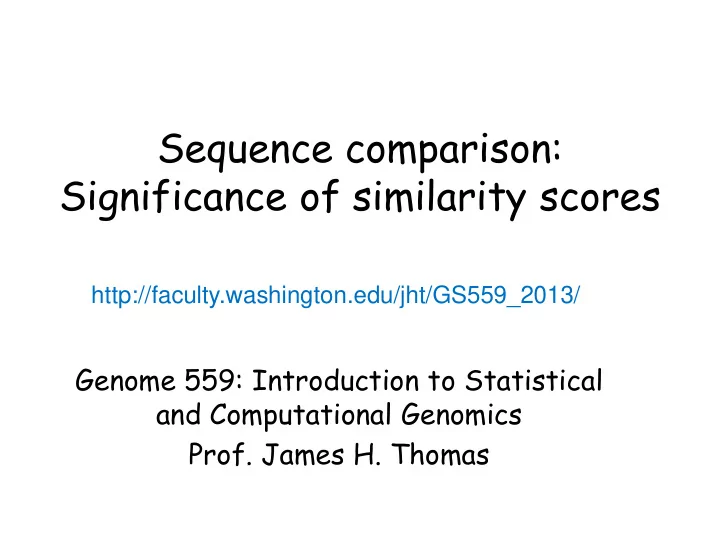

Sequence comparison: Significance of similarity scores http://faculty.washington.edu/jht/GS559_2013/ Genome 559: Introduction to Statistical and Computational Genomics Prof. James H. Thomas
Review • How to compute and use a score matrix. • log-odds of sum-of-pair counts vs. expected counts in aligned blocks. • Why gap scores should be affine.
Are these proteins related? (intuitive answers) SEQ 1: RVVNLVPS--FWVLDATYKNYAINYNCDVTYKLY NO (score = -1) L P L Y N Y C L identities-> SEQ 2: QFFPLMPPAPYFILATDYENLPLVYSCTTFFWLF SEQ 1: RVVNLVPS--FWVLDATYKNYAINYNCDVTYKLY PROBABLY (score = 15) L P W LDATYKNYA Y C L SEQ 2: QFFPLMPPAPYWILDATYKNYALVYSCTTFFWLF SEQ 1: RVVNLVPS--FWVLDATYKNYAINYNCDVTYKLY YES (score = 24) RVV L PS W LDATYKNYA Y CDVTYKL SEQ 2: RVVPLMPSAPYWILDATYKNYALVYSCDVTYKLF
Significance of scores HPDKKAHSIHAWILSKSKVLEGNTKEVVDNVLKT Alignment algorithm and 45 score matrix Low score = unrelated High score = related HADKRAHSIHAWLLSKSKVLGNTKEVVQNVLKS How high is high enough?
The null hypothesis • We first characterize the distribution of scores expected from sequences that are not related. • This assumption is called the null hypothesis. • The statistical test will be to determine whether the observed result provides a reason to reject the null hypothesis.
Sequence alignment score distribution Frequency Sequence alignment score • Use BLAST to search a randomly generated database of sequences using a given query sequence (recall that BLAST searches use DP local alignment). • What will be the form of the resulting distribution of pairwise alignment scores?
Empirical score distribution • Distribution of scores from a real database search using BLAST. Frequency • This distribution contains scores from a few related and lots of unrelated pairs. Score High scores from related sequences (note - there are lots of lower scoring alignments not reported)
Empirical null score distribution 1,685 scores • This distribution is similar to the previous one, but generated using a randomized sequence database (each sequence shuffled). (notice the x scale is shorter here) (note - there are lots of lower scoring alignments not reported)
Computing an empirical p-value • The probability of observing a score >=X is the area under the 'curve' to the right of X. • This probability is called a p-value. • p-value = Pr(data|null) (read as probability of data given a null hypothesis) e.g. out of 1,685 scores, 28 received a score of 20 or better. Thus, the p-value associated with a score of 20 is approximately 28/1685 = 0.0166.
Problems with empirical distributions • We are interested in very small probabilities. • These are computed from the tail of the null distribution. • Estimating a distribution with an accurate tail is feasible but computationally very expensive because we have to make a very large number of alignments.
A solution • Solution: characterize the form of the score distribution mathematically. • Fit the parameters of the distribution empirically (or compute them analytically if possible). • Use the resulting distribution to compute accurate p-values. • First solved by Karlin and Altschul.
Extreme value distribution (EVD) (aka Gumbel Distribution) This distribution is roughly normal near the peak, but has a longer tail on the right.
Computing a p-value • The probability of observing a score >=4 is the area under the curve to the right of 4. • p-value = Pr(data|null)
Unscaled EVD equation Compute this value for x=4. x ( e ) 1 P S x e S is data score, x is test score
Computing a p-value 4 ( e ) 4 1 P S e ( 4) 0.018149 P S
Other comments on probability distributions (FYI) • the PDF (probability density function) is the equation that generates the probability curve. • the CDF (cumulative distribution function) is the equation that describes the total area under the probability curve up to some point (inuitively the "area so far"). • for alignment scores we are interested in the area above some point. But since the total area under the curve is exactly 1, this is just 1 - CDF . • for the unscaled extreme value distribution (Gumbel): x ( e ) x CDF e x ( e ) PDF e e • and we want to compute 1 - CDF : x ( e ) 1 P S x e
Recommend
More recommend